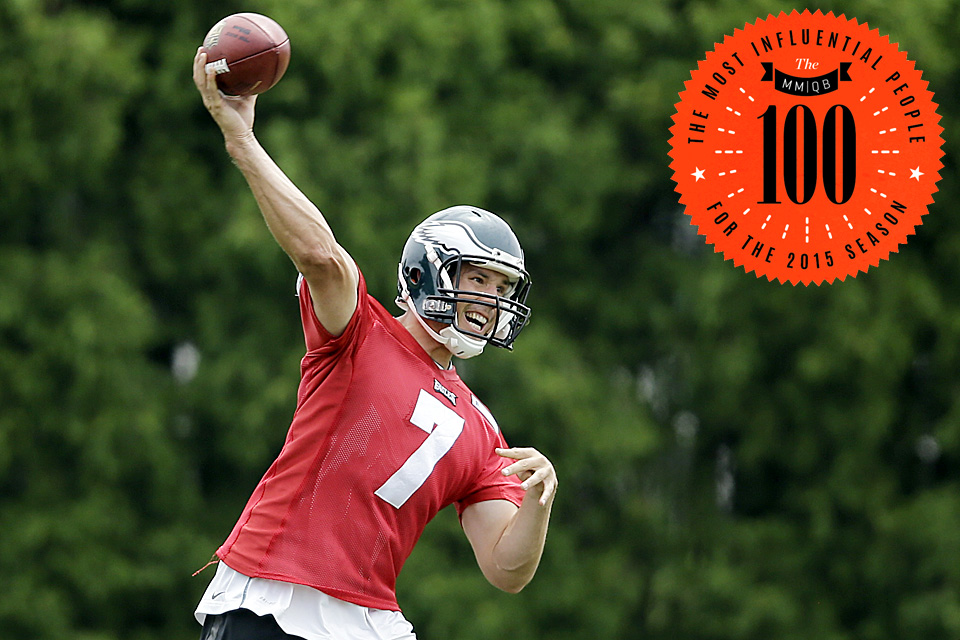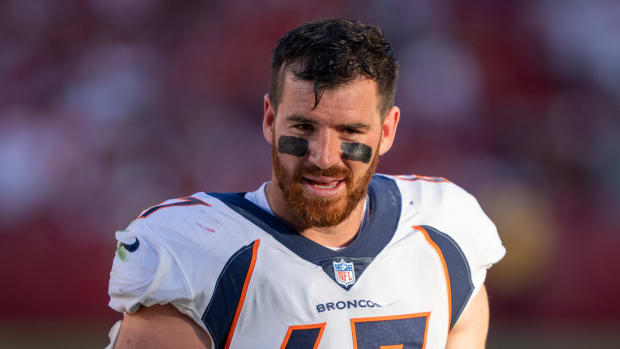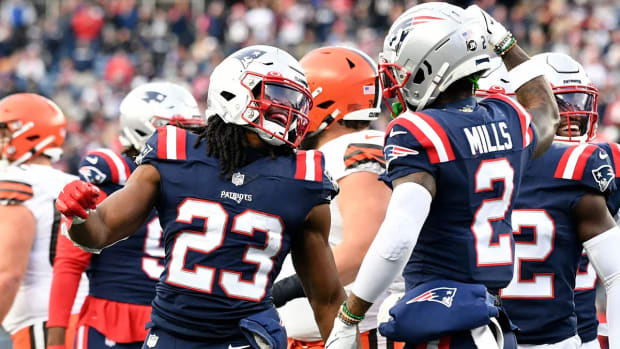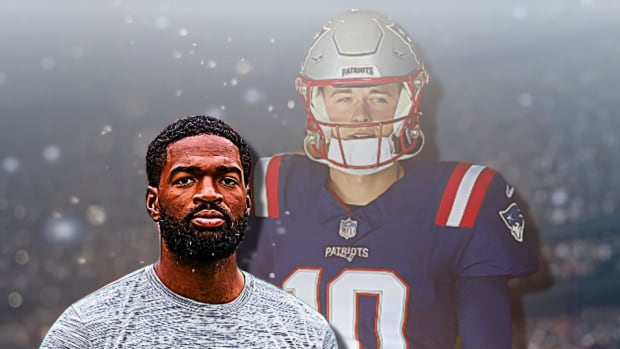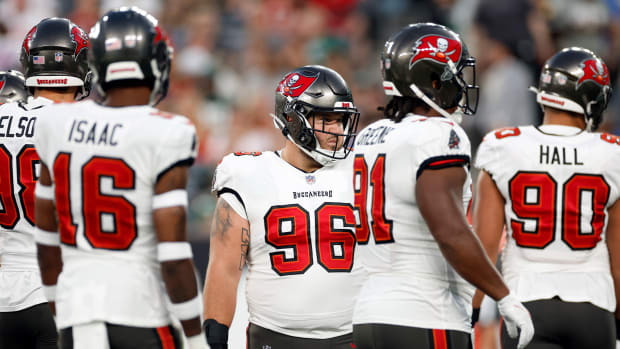No. 23: Sam Bradford
Editor’s note: This is part of our summer series, The MMQB 100, counting down the most influential people for the 2015 season.
A March 12 tweet from The Onion: “The trade for Sam Bradford proves the Eagles aren’t afraid of shaking up their injury report.”
Bradford, the first overall pick of the 2010 draft, has missed 31 games over the last four years, including 25 over the last two years with two different tears of his left ACL. And so NFL observers gaped when the Eagles acquired him in exchange for, essentially, 26-year-old quarterback Nick Foles and a 2016 second-round pick. With Bradford still rehabbing his knee at the time, the trade, in some ways, equated to Philly paying above blue book price for a car that’s in the shop.
Suspicions quickly arose that Eagles head coach Chip Kelly, who had recently taken full roster control from GM Howie Roseman, was making the first in what would be a series of moves to climb up from No. 20 to No. 2 in the draft to select Marcus Mariota. Stylistically, it goes without saying that the former Oregon QB is perfect for Kelly’s system—a system in which, Kelly, ideally, would feature 40-45 rushing attempts a game.
Introducing The MMQB’s ranking of the most influential figures for the 2015 season. THE LIST SO FARNos. 31-40: Odell Beckham Jr. is poised to become the dominant force the Giants need to get back to the playoffs, as well as one of the most recognizable faces in the NFLu2026 if he can handle the spotlight. Plus, Jimmy Graham, Andy Dalton, Gronk and more. FULL STORYNos. 41-50: Long essay on Mark Rodgers, the man negotiating Russell Wilson's new contract, plus Richard Sherman, Jimmy Garoppolo and more. FULL STORYNos. 51-60: Long essay on Bears QB Jay Cutler. Plus, Cam Newton, NaVorro Bowman, DeMarco Murray and more. FULL STORYNos. 61-70: Long essay on the late Junior Seau. Plus, Darrell Bevell, Cris Collinsworth and more. FULL STORY
Though the Eagles have ranked first and ninth in total rushing over the last two seasons, we’ve yet to see the full scope of Kelly’s ground attack. (Trading LeSean McCoy and releasing guard Evan Mathis reiterate just how far Kelly feels the Eagles are from having the type of ground game he actually wants.) Regardless of what Kelly says publicly, quarterback mobility is a significant facet of his scheme. That mobility brings another dimension to the read-option game, which, in Kelly’s scheme, at times plays off not just the usual unblocked defensive end but also off an unblocked defensive tackle.
There is a world of difference there. A defensive end lines up several yards away from the quarterback; a defensive tackle lines up almost within arm’s reach of the QB. A quarterback who can’t consistently run away from unblocked defensive tackles can’t run the full scope of Kelly’s option-based attack. Bradford is quicker and more athletic than the lumbering Foles, but he’s no Mariota.
In early May, Kelly acknowledged that Philly was interested in Tennessee’s No. 2 pick, telling NFL Network: “We examined it. I would say we were not very close, in terms of the price that was being asked. I used the analogy the other day that we drove into a very nice neighborhood and saw an unbelievable house, but when we found out the price of the house we stayed in the car, never even got out of the car.”
And so, sticking with Kelly’s analogy, the Eagles will settle for their fallback house. With his quicker release and tighter throwing motion, Bradford, stylistically, is more fit for Kelly’s passing game than Foles was. And if injuries strike again, the Eagles learned last season they can tread water with Mark Sanchez, who re-signed days before the Bradford trade.
Between now and Labor Day, you’ll probably hear Kelly say about a dozen times that Bradford is the guy the Eagles wanted all along. But if that’s true in its purest sense, the Eagles would sign Bradford to a long-term contract now, while his market value at its nadir. Basically, they are gambling with a wait-and-see approach on Bradford, who is making $12.985 million in this, the final year of his rookie contract. A successful 2015 season could add $10-20 million in guarantees to Bradford’s price tag next year. If he fails, he’ll be a free agent in 2016 and look for work as a backup.
Bradford is lucky to be in this position. Had the Rams been unable to trade him, they may have simply released him, leaving some other team to sign him for a fraction of $12.985 million. And if the Rams had kept Bradford, they would have asked him to take a pay cut and be the blandest kind of game-manager in their old-school ground-and-pound offense.
Football, 24/7
Keep up with the latest from Peter King and The MMQB.
Instead, Bradford will direct-deposit $1.5 million-plus every two weeks and lead an offense that can make even the most average quarterback look great (see: Foles, circa 2013). Remember, Bradford became the No. 1 pick in 2010 by thriving in an Oklahoma spread system that, just like Kelly’s, asked the quarterback to get the ball out quickly. Getting the ball out quickly stems from either diagnosing the defense before the snap, or from running plays in which the quarterback’s read is defined by the play design (bubble screens, quick slants, etc.).
In Philly, where the fast tempo leaves little time for pre-snap diagnostics, it’s all about defined reads. The system, especially in the aerial department, is the most simplistic in pro football. (How do you think all 11 Eagles are always able to play so fast?) Kelly’s playbook has essentially seven or eight total plays. But there’s an illusion of complexity because those plays are run out of many different formations. Any quarterback, particularly one with Bradford’s quick release, has a chance to prosper just by going through the correct motions.
We’ll learn two things about Bradford in 2015: (1) whether the 27-year-old’s once-promising career can ever get off the ground, and (2) whether Kelly can be convinced—truly convinced—that his system can function satisfactorily without a mobile quarterback. It’s this second item that has the rest of the NFL watching with bated breath. Kelly’s M.O. is the trendiest in football right now. His concepts are being copied more than anyone’s. If Bradford recognizes his full potential here, the copycatting will intensify. Maybe even to the degree of a league-wide revolution.
CLICK HERE TO SEE THE MMQB 100 SO FAR...
30. Jed York, CEO, San Francisco 49ers
It’s sort of a big year for the CEO of the San Francisco 49ers. For Super Bowl 50, the league chose the palatial and very green Levi’s Stadium, York’s progressive pride and joy in Santa Clara. The league is making quite a spectacle of it too. It’s Super Bowl 50. The owner of the Super Bowl host team is always a big newsmaker in that season, and the size of this year’s game makes that even more evident. The 35-year-old York could be on top of the world by the time of the Big Game, or he could be a punching bag for his rabid fan base. That’s because York made the biggest coaching move of the NFL off-season: He let Jim Harbaugh go and hired the inexperienced Jim Tomsula to replace him. By the end of Harbaugh’s rein, he and York were not getting along. At all. Harbaugh thought the front office (York or GM Trent Baalke, or both) were campaigning against him. York—though he has been careful to say nothing too critical of Harbaugh—obviously thought the coach was divisive and corrosive to a team-first organization. But over the next few years, York will be judged on the decision to shed Harbaugh and to hire Tomsula. This is why: For eight straight years before Harbaugh, the Niners didn’t have a winning season. In his first three regular seasons, he restored the glory of the franchise. San Francisco went 36-11-1 and reached the NFC title game three years in a row. The team went a ragged 8-8 last year. Speaking of coaches who divided organizations, Bill Walsh was pretty corrosive too. He lasted 10 years. He won three Super Bowls. Including playoffs he averaged 10.2 wins a year. Harbaugh lasted four years. He won no Super Bowls. Including playoffs he averaged 12.3 wins a year. York has been taking slings and arrows from Niner fans ticked off that Harbaugh is gone and the former defensive line coach, Tomsula, got the gem of a job. Fans don’t care that Harbaugh was increasingly difficult to get along with. They know that he, probably more than any single person, was responsible for taking the Niners from irrelevant to the Super Bowl. This is a very, very important year for the Niners—and not just for the coaches or the 53 players. The events York set in place will make him one of the year’s most-watched NFL people.
—Peter King (@SI_PeterKing)
* * *
29. Eric Grubman, Executive Vice President, NFL
Following two decades of proposals, drama, rumors and disappointment, it appears the NFL is finalizing its Los Angeles reprise. The red carpet isn’t ready to be rolled out just yet, so keep an eye on the man overseeing final logistics: NFL executive Eric Grubman. While Stan Kroenke, Dean Spanos and Mark Davis each have clout, all three report to Grubman, a longtime Goldman Sachs investment banker who holds influence at the league office. Grubman, the NFL’s chief dealmaker also has his hand in widening revenue streams and the league’s presence overseas (London calling?). But 2015 is all about the City of Angels. Grubman has been working on the L.A. soap opera for years, and hopes to direct the happy ending sometime this season.
—Emily Kaplan (@EmilyMKaplan)
* * *
28. Robert Griffin III, Quarterback, Washington
Look closely and you’ll see that Washington actually has a very good offense. One that could even be characterized as “loaded.” The addition of No. 5 overall pick Brandon Scherff and arrival of venerated O-line coach Bill Callahan turns an okay front five into a potentially dominant zone-blocking group. Alfred Morris is a smart zone runner, and the arrival of third-round rookie Matt Jones presents a much-welcomed alternate. Then there are the receiving weapons. Despite utter instability at quarterback last season, DeSean Jackson led the NFL with 13 receptions of 40-plus yards (the next highest total was Jordy Nelson’s eight). Pierre Garcon is an outstanding No. 2, capable of dominating at the intermediate levels, while tight end Jordan Reed, if healthy, has a legitimate chance to be what Aaron Hernandez would have become if he didn’t… well, you know. The only real question is at quarterback. Robert Griffin III is so badly lagging in his mechanics and understanding of defenses that the question isn’t how well Griffin will fare, but rather whether or not he’ll retain his starting job at all. If Griffin doesn’t keep the job this season, his once-promising career could be headed down the Tarvaris Jackson track, making coaches and GMs rethink the proposition of drafting a run-oriented quarterback.
—Andy Benoit (@Andy_Benoit)
* * *
27. Drew Brees, Quarterback, New Orleans Saints
The trouble with monster quarterback contracts has always been the subsequent struggle to build a competitive supporting cast under the salary cap. Perhaps no quarterback and team knows that better than Brees and the Saints, who agreed to a five-year extension in 2012 with cap hits of $17-, $18-, and $26 million in 2013, ’14 and ’15, respectively. The first casualty was Pro Bowl guard Carl Nicks, who signed in Tampa in 2012, and the hits kept coming. Brees took stock of the changing economic climate after falling to the Seahawks in the 2013 playoffs: “You also realize that in this league, in this day and age, some of those guys you're not going to be playing with anymore. There's a lot of turnover from year to year... It's a different team and you have to re-establish that identity each and every year.” Losing records in two of the last three seasons have exposed a porous offensive line and quite possibly the worst secondary in pro football. Can Brees possibly do enough to justify a $27.4 million cap hit in 2016, or will the celebrated Super Bowl champion, nine-time Pro Bowler and philanthropist take a pay cut to stay competitive? In any case, he enters 2015 in the wide-open NFC South without tight end Jimmy Graham for the first time since the All-Pro burst onto the scene in 2010. The burden on Brees only gets heavier.
—Robert Klemko (@RobertKlemko)
* * *
26. Jared Abbrederis, Wide Receiver, Green Bay Packers
No, we’re not really arguing that a 2014 fifth-round pick who spent his rookie year on injured reserve will be one of the most influential figures in the NFL this season. But think about it: At this point last summer, could anyone have foreseen that an undrafted Division II defensive back, who’d lingered on the Patriots practice squad and wasn’t far removed from a stint at Popeyes, would make the decisive play in Super Bowl 49? Or that a third-string Green Bay tight end with nine career catches would swing the NFC Championship Game with one flash of bad judgment and a pair of slippery hands? Every year some anonymous player—Super Bowl hero Malcolm Butler, NFC title game goat Brandon Bostick—plays a major role in a significant game, emerging from out of nowhere to stamp his imprint on the season, for good or bad. In past years it has been Malcolm Smith, Kyle Williams, David Tyree, Larry Brown, Timmy Smith. In 2001, a scrawny second-year backup QB stepped in for the injured starter in Week 2 and proceeded to lead his team to a Super Bowl victory. So take a bow, Jared Abbrederis: In the eyes of The MMQB, you stand for all the unknown, unsung battlers in the NFL—one of whom, we guarantee, will take his place in football history at some point in the 2015 season.
—Mark Mravic (@MarkMravic)
* * *
25. Jameis Winston, Quarterback, Tampa Bay Buccaneers
The No. 1 overall pick will always battle again outsized expectations. But Jameis Winston will face more scrutiny than any rookie in recent history. His exceptional talent may only be outweighed by the baggage that accompanied his arrival in Tampa. By now, America is well-versed in Winston’s tumultuous college career, both on and off the field. His rookie season could diverge one of two ways: Winston could demonstrate poise and maturity, show flashes of on-field greatness (besides his physical abilities, teams gushed about Winston’s game acumen through the draft process) and lift a franchise desperate for a return to respectability. With All-Pro-caliber receivers in Mike Evans and Vincent Jackson, Winston’s debut could be as impressive as Andrew Luck’s in 2012 or Matt Ryan’s in 2008. Or, Winston could fumble yet again. One more off-the-field incident could spell the end of his tenure as a franchise quarterback. And his coach (Lovie Smith), general manager (Jason Licht) and offensive coordinator (Dirk Koetter) could be collateral damage. So, Famous Jameis, which is it going to be?
—Emily Kaplan (@EmilyMKaplan)
* * *
24. Chris Borland, Retired Linebacker
A linebacker who won’t be playing this year, as the 24th-most influential person on the 2015 season? A third-round pick who played one NFL season, No. 24 on our list? And a pretty quiet, mostly private individual, with eight NFL starts in a promising but abbreviated career, No. 24 on our list? Chris Borland had a terrific rookie year—particularly the last two months—in San Francisco, earning praise and value for making 108 tackles in only three months. Then he was gone. Poof. He retired on March 16 because he feared the long-term effects of head trauma if he continued to play the game. “I just honestly want to do what’s best for my health,” he told ESPN in explaining his decision. “From what I’ve researched and what I’ve experienced, I don’t think it’s worth the risk.” What Borland did was courageous, particularly because he’d earned just $674,000 in his first year, after returning 75% of the signing bonus from his four-year contract. There was going to be much more where that came from, obviously, based on what a huge impact he had on the San Francisco defense as a rookie. And he made clear that he didn’t want to stand out as a voice in the wilderness, speaking about how football is too risky. It was for him. He doesn’t want to speak for the other 1,695 players in the league. “I would honestly like to move on from this beyond helping former players and their families,” he wrote when I reached out to speak with him in June. But it is apparent his decision had an impact on those players who have thought about leaving the game before their time. Said veteran Rams defensive end Chris Long: “Any player who says he hasn’t thought about it, any player who says he doesn’t think about the impact of the head trauma, is either lying or just being irresponsible. The generations before us didn’t know. The generation after us will know everything about the risks. Our generation—we have some information but certainly not all.” How significant will Borland be to 2015? The story is too young. It needs to play out. One of his teammates, tackle Anthony Davis, did walk away from the game at 24, citing the effects of head trauma. There hasn’t been a landslide. But let the story play out. We shall see how important this voice in the wilderness was.
—Peter King (@SI_PeterKing)
* * *
23. Sam Bradford, Quarterback, Philadelphia Eagles
A one-year fallback option for Chip Kelly, or a fallen star about to realize his potential? If Sam Bradford is ever going to re-establish himself as a franchise quarterback, this season, in this system, is the perfect opportunity. FULL STORY
* * *
22. Rex Ryan, Head Coach, Buffalo Bills
Rex Ryan arrived in Western New York promising (to no one’s surprise) games in January. The ex-Jets coach is already a cult figure in Buffalo despite having not yet coached a single game. After the previous Bills head coach, Doug Marrone, opted out of his contract, Ryan endeared himself to fans and players by changing the tattoo on his arm to Bills colors and turning his pickup into a Buffalo Bills-mobile. In other words, he’s all in. Since his hiring, the Bills have remade the roster in Ryan’s vision, securing a marquee running back (LeSean McCoy) to support his ground-and-pound philosophy and bringing in some of his favorite players from his Jets years. The roster has plenty of talent—McCoy, Sammy Watkins, Stephon Gilmore and possibly the best defensive line in the league—but it has the same flaw that has plagued Ryan for his entire head-coaching career thus far: No franchise quarterback. He’ll try to break the team’s 15-year playoff drought the same way he won in his early years in New York, with a suffocating defense, good special teams and a strong run game. But as the Bills’ new franchise record for season-ticket sales proves, one thing really is guaranteed: Ryan always makes things interesting.
—Jenny Vrentas (@JennyVrentas)
* * *
21. Ndamukong Suh, Defensive Tackle, Miami Dolphins
We won’t spill any more digital ink waxing poetic on the tradeoff of talent and liability you get with Suh, probably the league’s most dominant defensive lineman outside of J.J. Watt. It’s worth repeating the price Miami paid, though, for a famously emotionally volatile man in a league composed of emotionally volatile men: $60 million in guaranteed money with a $28.6 million cap hit in 2016. It’s more than the Lions were willing to pay to retain a four-time All-Pro who has missed exactly two games in five seasons. In a division with the Patriots, and in the process of an offensive line overhaul, is Suh’s presence the difference between 8-8 and a Super Bowl run? I’ll go out on a limb and say no, but the signing should, at least, keep some AFC East coordinators up nights figuring out how to stave Cameron Wake and a man with more sacks, hits and hurries (57) than any defensive tackle in football last season.
—Robert Klemko (@RobertKlemko)
































